Afforestation has been underperforming throughout Ireland with the exception of Cavan, Leitrim, Roscommon and Sligo. The decline has been particularly noticeable in Donegal where the planting programme has collapsed, but there has been a marked decline in counties which hitherto had large planting programmes carried out by private – mainly farmer – growers, especially Cork, Kerry, Limerick and Tipperary (Figure 1).
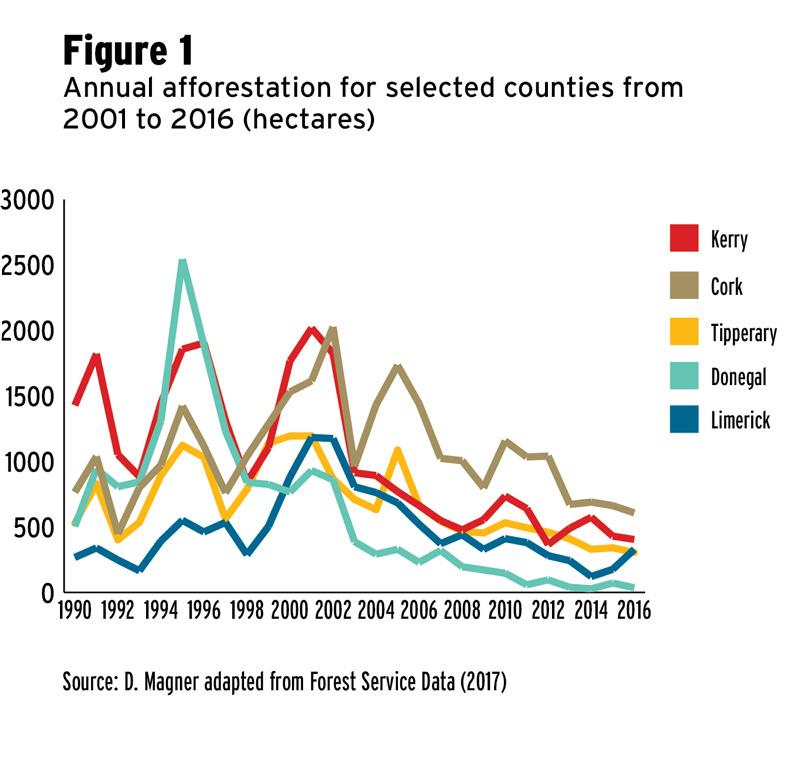
Munster in decline
The annual afforestation programme in Cork exceeded 2,000ha as recently as 2002 but over the past four years it has averaged 658ha with 608ha planted last year and the outlook for this year is just as bleak. At current afforestation rates, Cork will plant little over an extra 1% of the county by 2030 when most commentators believe that figure could be doubled without negatively affecting agriculture.
In Kerry, where annual afforestation reached 2,018ha in 2002 the fall is even more dramatic, down to 405ha last year. However, when the size of each county is factored in, Kerry is performing marginally better than Cork.
New planting in Limerick averaged over 1,000ha from 2000 to 2003, but went into decline eight years ago when it fell to 329ha. It recovered during the following two years but looked like it was in freefall in 2014 and 2015 when planting averaged 150ha. There was an upturn last year to 329ha.
Trends in Tipperary are similar with average annual afforestation over 1,000ha during the five-year period from 1998 to 2002. As recently as 2005, 1,007ha were planted but since then the decline has been significant with an average of 503ha planted during 2004 to 2011. Only 305ha were planted last year.
Clare is one of the more complex counties when assessing afforestation performance. In 2001, 1,457ha were planted, the highest afforestation programme ever in Ireland by land area. It gradually declined over the following 12 years to 347ha but picked up in 2014 to 420ha with 568ha and 542ha planted in 2015 and 2016 respectively. While this is well down on area planted at the turn of the century, at least the decline has been arrested.
Leinster decline
Afforestation in most of Leinster is much lower than the late 1990s but at least for counties such as Laois and Westmeath the annual returns, while low, are showing an overall slight increase in recent years. Westmeath has shown a gradual increase in planting from 144ha in 2007 to 163ha last year.
Offaly, which has had a consistent rather than spectacular planting programme, averaging 581ha from 1990 to 2001, has seen a gradual decline to 140ha over the past three years.
Galway and Mayo
Mayo has exceeded planting programmes of 1,000ha in the 1990s but only averaged 357ha from 2005-2008. Planting is extremely inconsistent in Mayo. The programme recovered in 2009 and 2011 – averaging over 500ha – but has dropped to 445ha over the past three years, an extremely poor return given the size of the county.
Galway has maintained a modest but consistent programme over the past decade averaging over 400ha annually, but fell to 331ha last year.
Connacht and border
Cavan, Leitrim, Roscommon and Sligo are the only counties to increase planting significantly in recent years (Table 1). Trends have been uneven in Sligo, where 524ha were planted in 2001. In 2011 only 87ha were planted but afforestation was up last year to 302ha.
Likewise, Leitrim which had an afforestation programme of 600ha in the 1990s was still capable of planting 600ha by 2001 but by 2010 it had fallen to 176ha. Since then it has recovered as 435ha were planted last year. Cavan and Roscommon have also recovered; from around 300ha 10 years ago to over 400ha last year.
These four counties comprise 11% of the land area of Ireland but currently contribute 25% of afforestation, albeit a drastically reduced national planting programme.
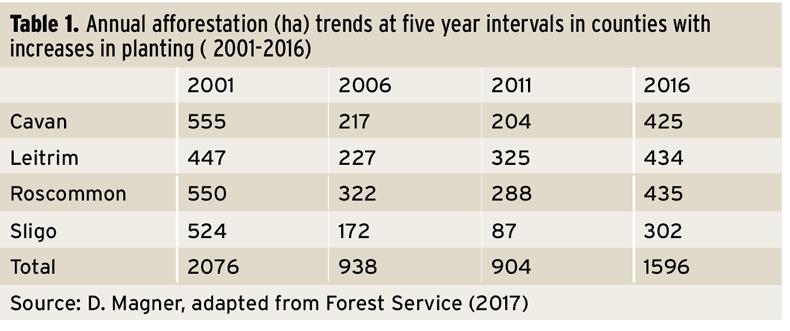
Private forestry investment
It was believed by some commentators that private forestry investment would increase from 2015 when the premium differentiation between farmer and non-farmer was abolished. While forestry provides a lucrative return on investment for farmers even with small forests, investors tend to source larger blocks of land.
Two years into the new programme, it is difficult to see where large scale investment is taking place, in particular institutional investment. Only 3% of plantations established over the last five years exceeded 20ha.
Average plantation size continues to decrease. Nationally it is now only 6.4ha and is only 6.5ha in counties Cavan, Leitrim, Roscommon and Sligo.
Balanced programme
The objective should be to achieve an annual geographically balanced afforestation programme of 7,000ha in 2017 rising to 8,000ha by 2020 as specified in the Department’s own planting targets. This would require all counties planting 0.1% to 0.15% of their land annually with the exception of Louth, Meath, Kildare and Dublin where minimal planting can be carried out.
The department’s own annual target for 2020 is broadly in line with the 2006 annual planting programme of 8,037ha. Cork, Tipperary, Kerry and Limerick planted 3,289ha then, but their performance fell to 1,647ha in 2016. The target therefore in these four counties is to restore planting to the levels achieved in 2006 which will require doubling annual afforestation by 2020.
The recent proposals by the Irish Forestry and Forest Products Association in IBEC along with nurseries and forestry companies to actively monitor afforestation performance by month, by county, by applications, by approvals and by trees planted is a practical way to deliver a programme that matches expectations of the forest industry and the department’s own targets.
These proposals will be put to the test over the coming months and years as will the department’s welcome commitment to do “everything it can to achieve the Forestry Programme targets,” as announced recently.
All stakeholders involved in the afforestation programme need to target counties where planting decline continues unabated, especially Cork, Tipperary, Kerry and Limerick to avoid a similar collapse to Donegal.
This month four years ago I discussed the afforestation programme with Michael Fleming during a visit to northwest Cork and east Kerry. The then-chair of the IFA forestry committee had been involved in discussions with the EU, Forest Service, Department, National Parks and Wildlife Service (NPWS) about the falling afforestation programme nationally. While he was concerned about national forestry issues, he also outlined the potential of forestry in Cork and Kerry from his own perspective as a successful farmer, forest owner and contractor, based in Rathmore.
Forestry has a healthy visibility here, where lorries hauling timber to sawmills, stake producers and energy outlets are a familiar sight.
Lack of
consultation
We visited one of his more recently established plantations between Newmarket and Ballydesmond, which ticked all the economic, environmental and biodiversity boxes required for sustainable forest management.
When I asked why more of this marginal land wasn’t planted in adjoining sites, he replied that no further afforestation would be allowed in the area because the NPWS had suspended the National Management Protocol for hen harrier Special Protection Areas (SPAs) without consultation.
The protocol was agreed in March 2007 by the Government and all relevant stakeholders including the IFA. He maintained that the findings of research carried out in University College Cork (UCC) on the hen harrier show that the safeguards agreed in the protocol were working.
He maintained that the best of land was being precluded from forestry by the NPWS in hen harrier designated areas and by the Forest Service in excellent unenclosed land without environmental constraints as well as acid sensitive areas.
He had a proactive approach to protecting the environment and couldn’t understand the Forest Service and NPWS decisions, especially as they were taken without any meaningful consultation with the key stakeholders – the farmers – who work the land and who grow the timber to supply the timber processing sector.
Land abandonment
He maintained that there was sufficient land – enclosed and unenclosed – to provide a viable afforestation programme, but feared that blanket bans and restrictions were too prohibitive.
“There is a risk of land abandonment if local farmers are not permitted to afforest and engage in economic production on their farms,”he said in a measured tone which made the statement all the more chilling.
Like others, he was worried about forestry companies, landowners and contractors abandoning forestry just as they had already done in Co Donegal where annual afforestation had fallen from 2,544ha to a 36ha.
He proposed a site-by-site evaluation with potential for forestry with the farmer at the centre of decision making, not on the periphery.
Otherwise he cautioned that planting would dramatically decrease, beginning in his own hinterland. Four years on, the fears he expressed about the future dramatic decline of afforestation were well founded.
Read more
Editorial: failure to hit forestry targets
Afforestation has been underperforming throughout Ireland with the exception of Cavan, Leitrim, Roscommon and Sligo. The decline has been particularly noticeable in Donegal where the planting programme has collapsed, but there has been a marked decline in counties which hitherto had large planting programmes carried out by private – mainly farmer – growers, especially Cork, Kerry, Limerick and Tipperary (Figure 1).

Munster in decline
The annual afforestation programme in Cork exceeded 2,000ha as recently as 2002 but over the past four years it has averaged 658ha with 608ha planted last year and the outlook for this year is just as bleak. At current afforestation rates, Cork will plant little over an extra 1% of the county by 2030 when most commentators believe that figure could be doubled without negatively affecting agriculture.
In Kerry, where annual afforestation reached 2,018ha in 2002 the fall is even more dramatic, down to 405ha last year. However, when the size of each county is factored in, Kerry is performing marginally better than Cork.
New planting in Limerick averaged over 1,000ha from 2000 to 2003, but went into decline eight years ago when it fell to 329ha. It recovered during the following two years but looked like it was in freefall in 2014 and 2015 when planting averaged 150ha. There was an upturn last year to 329ha.
Trends in Tipperary are similar with average annual afforestation over 1,000ha during the five-year period from 1998 to 2002. As recently as 2005, 1,007ha were planted but since then the decline has been significant with an average of 503ha planted during 2004 to 2011. Only 305ha were planted last year.
Clare is one of the more complex counties when assessing afforestation performance. In 2001, 1,457ha were planted, the highest afforestation programme ever in Ireland by land area. It gradually declined over the following 12 years to 347ha but picked up in 2014 to 420ha with 568ha and 542ha planted in 2015 and 2016 respectively. While this is well down on area planted at the turn of the century, at least the decline has been arrested.
Leinster decline
Afforestation in most of Leinster is much lower than the late 1990s but at least for counties such as Laois and Westmeath the annual returns, while low, are showing an overall slight increase in recent years. Westmeath has shown a gradual increase in planting from 144ha in 2007 to 163ha last year.
Offaly, which has had a consistent rather than spectacular planting programme, averaging 581ha from 1990 to 2001, has seen a gradual decline to 140ha over the past three years.
Galway and Mayo
Mayo has exceeded planting programmes of 1,000ha in the 1990s but only averaged 357ha from 2005-2008. Planting is extremely inconsistent in Mayo. The programme recovered in 2009 and 2011 – averaging over 500ha – but has dropped to 445ha over the past three years, an extremely poor return given the size of the county.
Galway has maintained a modest but consistent programme over the past decade averaging over 400ha annually, but fell to 331ha last year.
Connacht and border
Cavan, Leitrim, Roscommon and Sligo are the only counties to increase planting significantly in recent years (Table 1). Trends have been uneven in Sligo, where 524ha were planted in 2001. In 2011 only 87ha were planted but afforestation was up last year to 302ha.
Likewise, Leitrim which had an afforestation programme of 600ha in the 1990s was still capable of planting 600ha by 2001 but by 2010 it had fallen to 176ha. Since then it has recovered as 435ha were planted last year. Cavan and Roscommon have also recovered; from around 300ha 10 years ago to over 400ha last year.
These four counties comprise 11% of the land area of Ireland but currently contribute 25% of afforestation, albeit a drastically reduced national planting programme.

Private forestry investment
It was believed by some commentators that private forestry investment would increase from 2015 when the premium differentiation between farmer and non-farmer was abolished. While forestry provides a lucrative return on investment for farmers even with small forests, investors tend to source larger blocks of land.
Two years into the new programme, it is difficult to see where large scale investment is taking place, in particular institutional investment. Only 3% of plantations established over the last five years exceeded 20ha.
Average plantation size continues to decrease. Nationally it is now only 6.4ha and is only 6.5ha in counties Cavan, Leitrim, Roscommon and Sligo.
Balanced programme
The objective should be to achieve an annual geographically balanced afforestation programme of 7,000ha in 2017 rising to 8,000ha by 2020 as specified in the Department’s own planting targets. This would require all counties planting 0.1% to 0.15% of their land annually with the exception of Louth, Meath, Kildare and Dublin where minimal planting can be carried out.
The department’s own annual target for 2020 is broadly in line with the 2006 annual planting programme of 8,037ha. Cork, Tipperary, Kerry and Limerick planted 3,289ha then, but their performance fell to 1,647ha in 2016. The target therefore in these four counties is to restore planting to the levels achieved in 2006 which will require doubling annual afforestation by 2020.
The recent proposals by the Irish Forestry and Forest Products Association in IBEC along with nurseries and forestry companies to actively monitor afforestation performance by month, by county, by applications, by approvals and by trees planted is a practical way to deliver a programme that matches expectations of the forest industry and the department’s own targets.
These proposals will be put to the test over the coming months and years as will the department’s welcome commitment to do “everything it can to achieve the Forestry Programme targets,” as announced recently.
All stakeholders involved in the afforestation programme need to target counties where planting decline continues unabated, especially Cork, Tipperary, Kerry and Limerick to avoid a similar collapse to Donegal.
This month four years ago I discussed the afforestation programme with Michael Fleming during a visit to northwest Cork and east Kerry. The then-chair of the IFA forestry committee had been involved in discussions with the EU, Forest Service, Department, National Parks and Wildlife Service (NPWS) about the falling afforestation programme nationally. While he was concerned about national forestry issues, he also outlined the potential of forestry in Cork and Kerry from his own perspective as a successful farmer, forest owner and contractor, based in Rathmore.
Forestry has a healthy visibility here, where lorries hauling timber to sawmills, stake producers and energy outlets are a familiar sight.
Lack of
consultation
We visited one of his more recently established plantations between Newmarket and Ballydesmond, which ticked all the economic, environmental and biodiversity boxes required for sustainable forest management.
When I asked why more of this marginal land wasn’t planted in adjoining sites, he replied that no further afforestation would be allowed in the area because the NPWS had suspended the National Management Protocol for hen harrier Special Protection Areas (SPAs) without consultation.
The protocol was agreed in March 2007 by the Government and all relevant stakeholders including the IFA. He maintained that the findings of research carried out in University College Cork (UCC) on the hen harrier show that the safeguards agreed in the protocol were working.
He maintained that the best of land was being precluded from forestry by the NPWS in hen harrier designated areas and by the Forest Service in excellent unenclosed land without environmental constraints as well as acid sensitive areas.
He had a proactive approach to protecting the environment and couldn’t understand the Forest Service and NPWS decisions, especially as they were taken without any meaningful consultation with the key stakeholders – the farmers – who work the land and who grow the timber to supply the timber processing sector.
Land abandonment
He maintained that there was sufficient land – enclosed and unenclosed – to provide a viable afforestation programme, but feared that blanket bans and restrictions were too prohibitive.
“There is a risk of land abandonment if local farmers are not permitted to afforest and engage in economic production on their farms,”he said in a measured tone which made the statement all the more chilling.
Like others, he was worried about forestry companies, landowners and contractors abandoning forestry just as they had already done in Co Donegal where annual afforestation had fallen from 2,544ha to a 36ha.
He proposed a site-by-site evaluation with potential for forestry with the farmer at the centre of decision making, not on the periphery.
Otherwise he cautioned that planting would dramatically decrease, beginning in his own hinterland. Four years on, the fears he expressed about the future dramatic decline of afforestation were well founded.
Read more
Editorial: failure to hit forestry targets









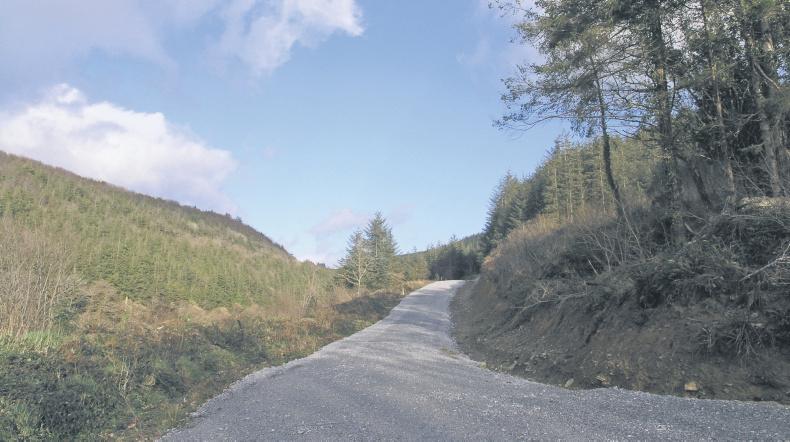
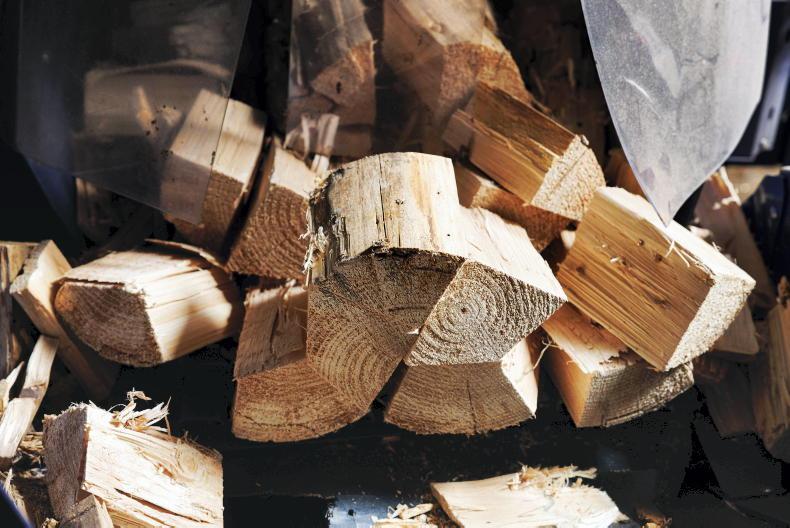

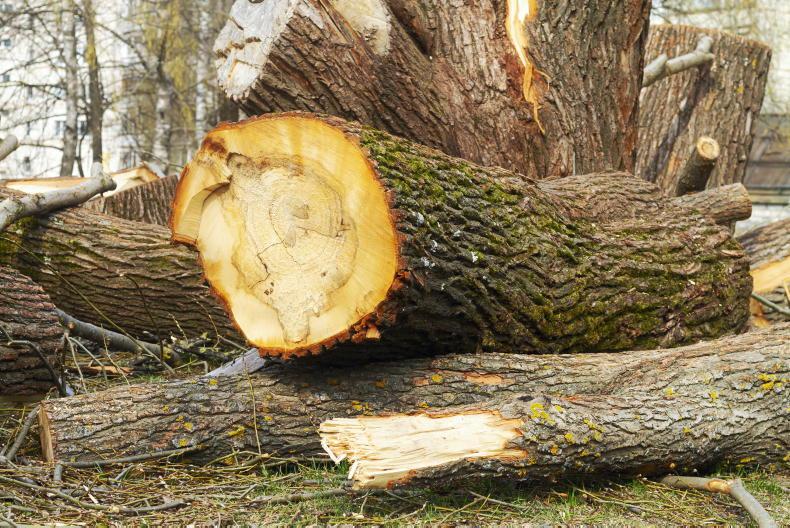


SHARING OPTIONS